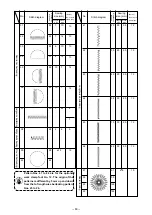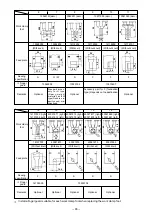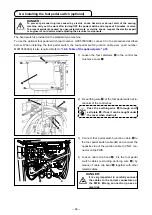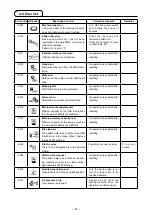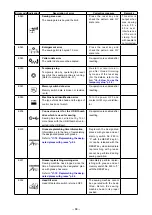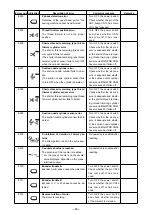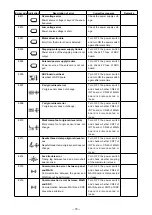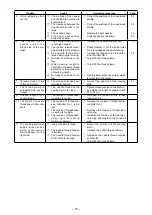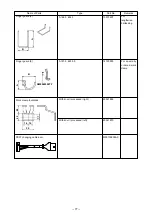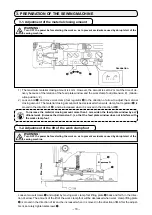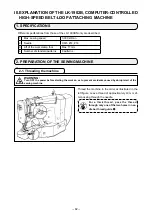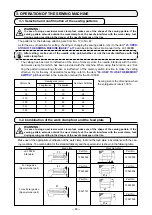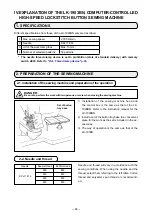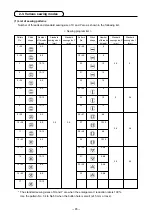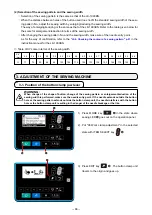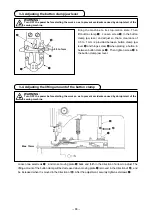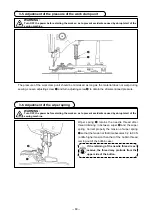
-
75
-
Trouble
Cause
Corrective measures
Page
5. Stitch skipping often
occurs.
①
The motions of the needle
and shuttle are not properly
synchronized.
②
The clearance between the
needle and shuttle is too
large.
③
The needle is bent.
④
The driver excessively
bends the needle.
◦
Correct the positions of the needle and
shuttle.
◦
Correct the positions of the needle and
shuttle.
◦
Replace the bent needle.
◦
Correctly position the driver.
6. T h e n e e d l e t h r e a d
c o m e s o u t o n t h e
wrong side of the ma-
terial.
①
The needle thread tension
is not high enough.
②
The tension release mech-
anism fails to work properly.
③
The needle thread after
thread trimming is too long.
④
Number of stitches is too
few.
⑤
When sewing length is
short (End of needle thread
protrudes on the wrong side
of sewing product.)
⑥
Number of stitches is too
few.
◦
Increase the needle thread tension.
◦
Check whether or not the tension disc
No. 2 is released during bar-tracking.
◦
Increase the tension of the thread ten-
sion controller No. 1.
◦
Turn OFF the thread clamp.
◦
Turn OFF the thread clamp.
◦
Use the lower plate, the hole of which
is larger than the presser.
7. Threads break at time
of thread trimming.
①
The moving knife has been
improperly position.
◦
Correct the position of the moving
knife.
8. The thread clamp is
entangled with needle
thread.
①
The needle thread at the
sewing start is too long.
◦
Tighten thread tension controller No. 1
and make the length of needle thread
33 to 36 mm.
9. Uneven length of the
needle thread
①
The tension of thread take-
up spring is too low.
◦
Increase the tension of the thread
take-up spring.
10. The length of needle
thread does not become
short.
①
The tension of thread ten-
sion controller No. 1 is too
low.
②
The tension of thread take-
up spring is too high.
③
The tension of thread take-
up spring is too low and
motion is unstable.
◦
Increase the tension of thread tension
controller No. 1.
◦
Decrease the tension of thread take-
up spring.
◦
Increase the tension of thread take-
up spring and lengthen the stroke as
well.
11. The knotting section of
bobbin thread at 2nd
stitch at the sewing
start appears on the
right side.
①
Idling of bobbin is large.
②
The bobbin thread tension
is too low.
③
The needle thread tension
at 1st stitch is too high.
◦
Adjust the position of the moving
knife.
◦
Increase the bobbin thread tension.
◦
Decrease the needle thread tension
at 1st stitch.
◦
Turn OFF the thread clamp.
Trouble
Cause
Corrective measures
Page
1. T h e n e e d l e t h r e a d
slips off at the start of
bar-tacking.
①
Stitches are slipped at the
start.
②
The needle thread remain-
ing on the needle after
thread trimming is too short.
③
The bobbin thread is too
short.
④
Needle thread tension at
1st stitch is too high.
⑤
Thread clamp is unstable
(material is apt to be ex-
panded, thread is hard to
slide, thread is thick, etc.).
⑥
Pitch at 1st stitch is too
small.
◦
Adjust the clearance between the nee-
dle and the shuttle to 0.05 to 0.1 mm.
◦
Set soft-start sewing at the start of
bartacking.
◦
Correct the thread tension release tim-
ing of the thread tension controller No. 2.
◦
Increase the tension of the thread
take-up spring, or decrease the ten-
sion of the thread tension controller
No. 1.
◦
Decrease the tension of the bobbin
thread.
◦
Increase the clearance between the
needle hole guide and the counter
knife.
◦
Decrease the tension at 1st stitch.
◦
Decrease the number of rotation at
1st stitch at the sewing start. (Extent
of 600 to 1,000 sti/min)
◦
Increase the number of stitches of
thread clamp to 3 to 4 stitches.
◦
Make the pitch at 1st stitch longer.
◦
Decrease the needle thread tension
at 1st stitch.
2. Thread often breaks or
synthetic fiber thread
splits finely.
①
The shuttle or the driver
has scratches.
②
The needle hole guide has
scratches.
③
The needle strikes the work
clamp foot.
④
F i b r o u s d u s t i s i n t h e
groove of the shuttle race.
⑤
The needle thread tension
is too high.
⑥
The tension of the thread
take-up spring is too high.
⑦
The synthetic fiber thread
melts due to heat generat-
ed on the needle.
◦
Take it out and remove the scratches
using a fine whetstone or buff.
◦
Buff or replace it.
◦
Correct the position of the work clamp
foot.
◦
Take out the shuttle and remove the
fibrous dust from the shuttle race.
◦
Reduce the needle thread tension.
◦
Reduce the tension.
◦
Use silicone oil.
3. T h e n e e d l e o f t e n
breaks.
①
The needle is bent.
②
The needle hits the work
clamp foot.
③
The needle is too thin for
the material.
④
The driver excessively
bends the needle.
⑤
Needle thread is stepped
on by the work clamp foot
at the start of sewing.
(Needle bend)
◦
Replace the bent needle.
◦
Correct the position of the work clamp
foot.
◦
Replace it with a thicker needle ac-
cording to the material.
◦
Correctly position the needle and the
shuttle.
◦
Widen the distance between the nee-
dle and the wiper. (23 to 25 mm)
4. T h r e a d s a r e n o t
trimmed.
(Bobbin thread only)
①
The counter knife is dull.
②
The difference in level
between the needle hole
guide and the counter knife
is not enough.
③
The moving knife has been
improperly positioned.
④
The last stitch is skipped.
⑤
Bobbin thread tension is
too low.
◦
Replace the counter knife.
◦
Increase the bend of the counter knife.
◦
Correct the position of the moving
knife.
◦
Correct the timing between the needle
and the shuttle.
◦
In crease the bobbin thread tension.



